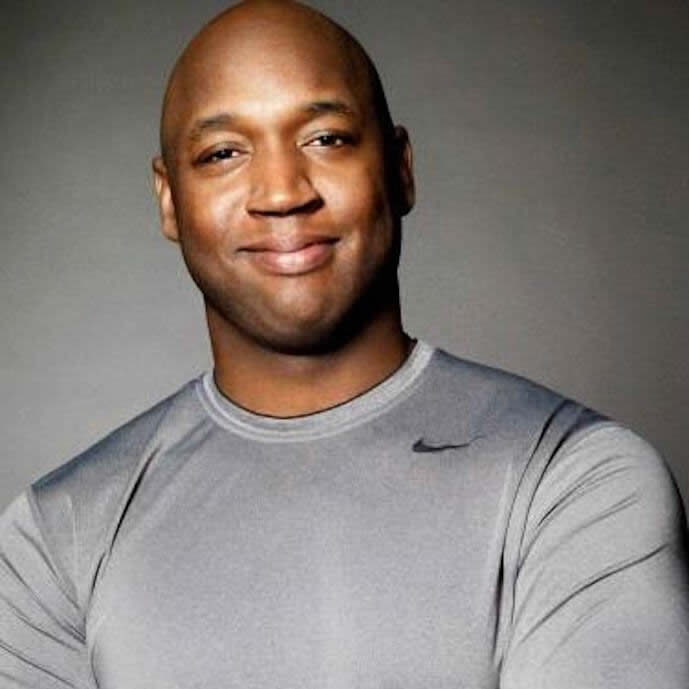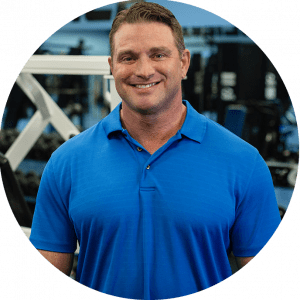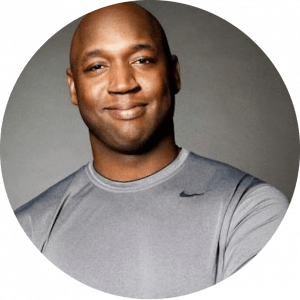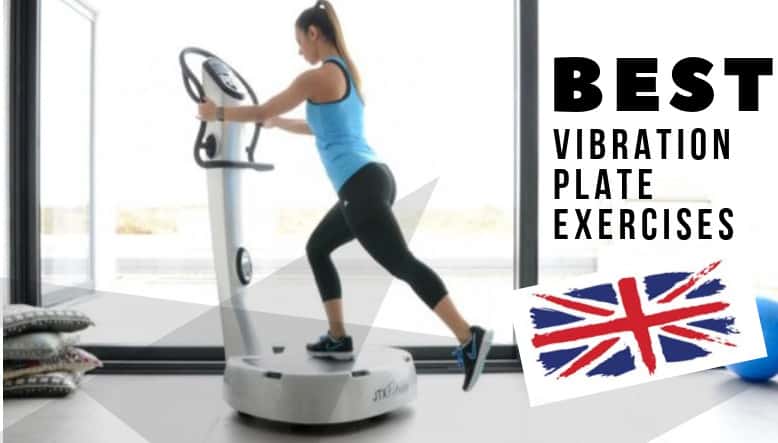
So you’re a proud new owner of a vibration plate, now all you need to do is get on it and do some vibration plate exercises.
You may have received some kind of guidance about vibration plate exercises when you bought your vibration plate, but we know that long lists of vibration plate exercises can be a bit intimidating, especially when you’re new to vibration plates, so here’s a quick and handy guide to help you along.
For this guide, we’re going to assume that you’re a beginner to vibration plate exercises and that you want a whole-body workout but are particularly interested in toning your lower body.
Where relevant, we’ll mention ways to adapt the exercises to different levels of fitness and remember that the duration is the maximum recommended duration for a person of decent fitness. If you can only manage less for the time being, or at all, then that’s fine.
Not even got the plate?!? Read ourVibration plate reviews guide
Best Vibration Plate Exercises
Shoulder Stretch
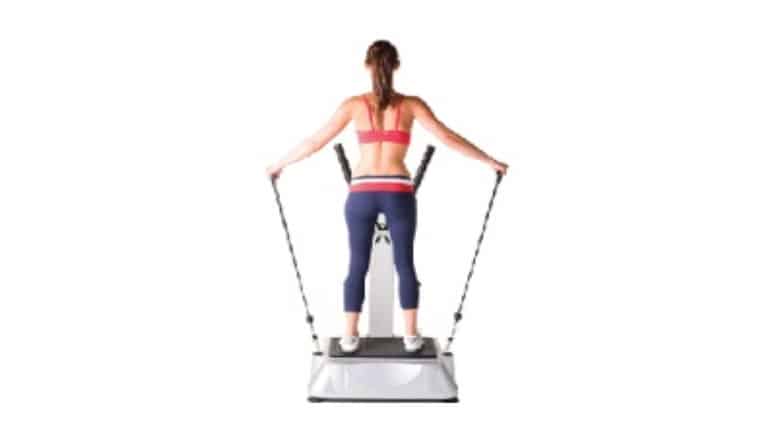
Muscles Worked – Arms, Shoulders, Back
Frequency: 22 – 28 Hz
Duration: 30 seconds
For this you’ll need hand straps, most vibration plates come with them and if not (or if you somehow lose them) they can be bought seperately. Stand on the platform, feet an equal distance apart. You want them no wider than your hips, but hip distance is generally best for balance. Pull on the straps until your lower arm forms a right angle with your upper arm at the elbow. Pull your shoulder blades back as far as you can. Hold.
Plank
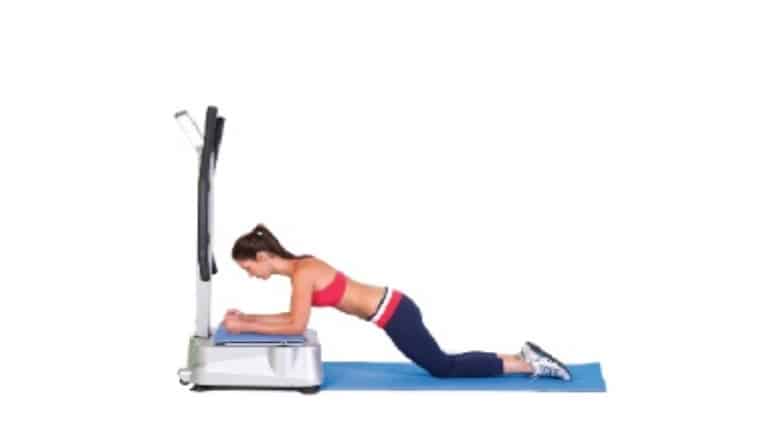
Muscles Worked – Arms, Back, Core, Legs
Frequency: 14 – 24 Hz
Duration: 30 Seconds
Put your forearms on the platform (if you don’t use a cushioned mat you might want long sleeves). Push your lower body away from the platform until your back is straight with your knees on the floor. Then either:
1: lift your bodyweight so it goes through your knees and into your calves, both of which stay on the floor.
or
2: lift your bodyweight up off the platform and your knees off the floor so only your toes remain in contact with the floor.
Hold Ups
You may want to start with option one and work your way up to option two.

Muscles Worked – Back, Chest, Shoulders, Lower Body
Frequency: 22 – 28Hz
Duration: 15 seconds
This time you want to adopt the same sort of position for the plank, except that instead of your forearms being on the platform, you want your palms to be on the platform. You’ll then raise up your upper body, as far as you comfortably can while keeping the elbow bent. Depending on your level of fitness, you may choose to keep your knees and lower legs on the floor or just your toes on the floor. Hold.
Jack Knife

Muscles Worked – Back, Abdominals
Frequency: 22- 28Hz
Duration: 30 Seconds
For this one, we’d suggest you start by sitting with your back to the vibration plate and then swivel round to place your feet on the platform keeping your knees bent and your back flat on the floor with your arms out beside you. Raise your body from the hips as far as you comfortably can and hold.
Leg Crunches

Muscles Worked – abdominal
Frequency: 14 – 20 Hz
Duration: 15 Seconds
Sit in the centre of the plate. You want your bottom tucked under you and your weight on it. Place your hands behind you so that they are comfortable on the plate and can add a bit of balance. Make sure your elbows stay bent. This will probably involve you leaning back a bit, this is fine, just remember to keep your back straight.
The basic version of this exercise is to raise your legs as high as you comfortably can, while maintaining good posture in your upper body and hold for 15 seconds. We would really like to emphasize how important it is to keep the posture we described above and keep the weight load on your abdominals rather than your back and/or shoulders.
Once you have the basic version of leg crunches down pat, you can try varying it to suit your own needs. The more frequently you do this exercise, the more you will come to understand what muscles, exactly, are working at what point and so if you have specific needs or wants, you’ll learn, through experience, to tailor this exercise to them.
Squats
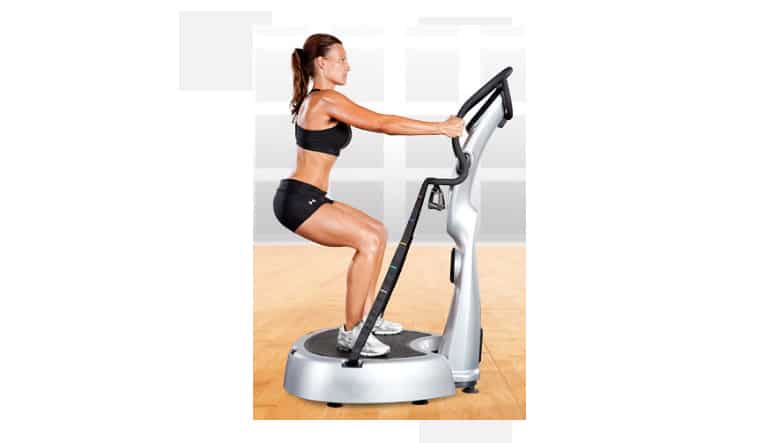
Muscles Worked – Thighs
Frequency: 23 – 28 Hz
Duration: 30 Seconds
Take up the classic “squat position”, which is feet shoulder width apart (or a little wider), toes pointing forward, knees slightly bent.
Either stretch out your arms so they are parallel to the ground or, if you prefer, take a grip of your hand bars. If you go for the latter option, remember that the bars are purely for comfort and balance, your body weight should be over your thighs. That being so, you may need to move a bit further forward to ensure that you can lower your hips without either losing your balance or bending your back. It’s really important that your back stays straight throughout this exercise.
Keeping your upper body posture, lower your hips, as though you were sitting down on an imaginary chair and hold. Ideally, the chair shape is the exact silhouette you want to achieve with your hips more or less at knee level, but if this is beyond your current level of fitness, that’s fine, just do what you can.
Quad Stretch
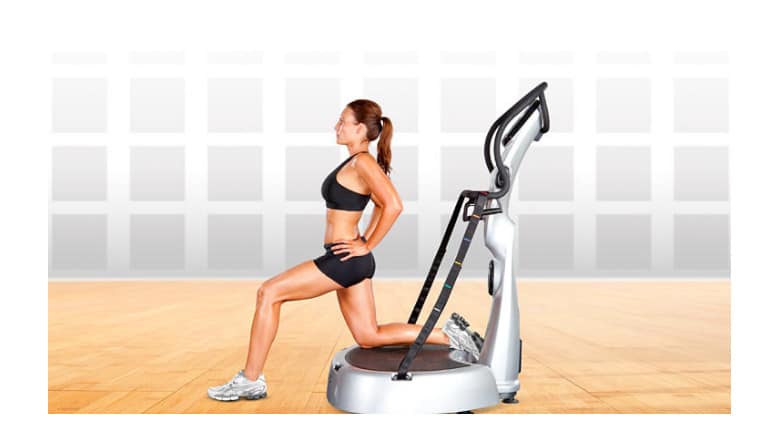
Muscles Worked – Quadriceps, Hip Flexor
Frequency: 18 – 24Hz
Duration: 30 Seconds
This is an exercise where most people will probably feel a definite benefit from using a cushioned mat. If you don’t have one, you could use thicker trousers (e.g. jogging trousers rather than lycra leggings) or put some form of cushioning on the platform, such as a blanket or cushion.
Face away from the vibration plate and put the lower part of one leg on the plate with the knee resting on the padding. Position your other leg so that it can hold your weight and keep you stable. You will need to bring the hip on that side forward and you may find it helps to rest your hand on your supporting thigh. Your foot should be pointing forwards and, as always, keep your back straight.
When you are ready, bend the knee which is on the plate so your lower leg lifts up and, if necessary, adjust your position from the other knee and hip to compensate, keeping your back straight. Hold.
Lunges

Muscles Worked – Legs, lower Body
Frequency: 22 – 28 Hz
Duration: 30 seconds
Put one foot flat on the plate, toes pointing forwards. Bend your forwards leg until your knee makes a right angle. This will mean moving your body forwards, so move from the hips and keep your back straight. Let your backwards leg bend naturally, so it can provide stability. Let your heel come off the floor so that only your toe is in contact with the ground. Basically your silhouette should look like you are taking a very large step up a fairly high stair.
You can put your hands wherever you like, but it’s usually easiest to rest them on your hips. If you have your weight properly centred, you should be able to balance just fine without them.
When you are comfortable, bend from your front knee, letting your hips and following knee sink down naturally. Hold.
NB: If you have the correct posture, your weight should be supported by your thighs and core, not your knees or your back. If you are feeling pain in these areas, then you need to adjust your posture. If you’re not sure how to correct your posture, then just end the exercise.
Heel Raise
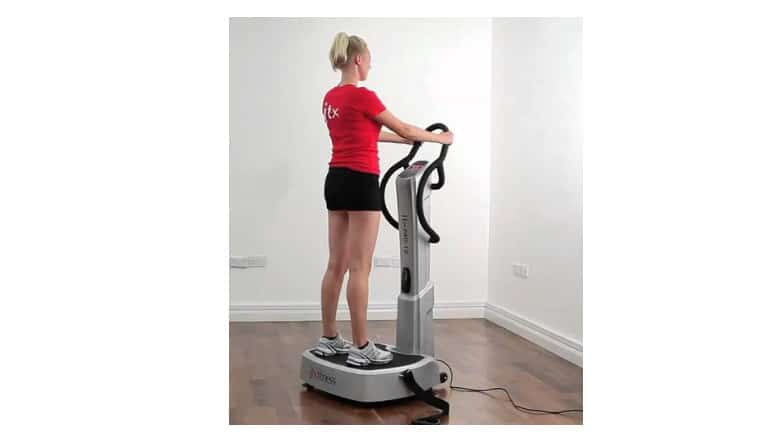
Muscles Worked – Calves
Frequency: 23-28 Hz
Duration: 15 Seconds
Stand in the centre of your plate, feet an equal distance apart, roughly in line with your shoulders. It’s fine to rest your hands on the bars, but keep your back straight and your hips square. When you are ready, raise yourself onto your toes and hold.
A final note
This is not even remotely close to being all the vibration plate exercises there are, but it is certainly enough to give the average person a very decent workout and, even accounting for the fact that some exercises have to be done twice (for each side), you can see how little time vibration plate exercises take compared to an aerobics class or yoga.
While vibration plates allow for low-impact exercise, always remember basic work-out safety such as warming up, cooling down and keeping hydrated. Similarly remember that the exercises require you to keep your body weight over the designated muscles, not your joints or back. If you feel a strain on your joints or back, you are doing something wrong. It may help to position your vibration plate near a mirror, at least to start with, so you can literally see what you’re doing.

